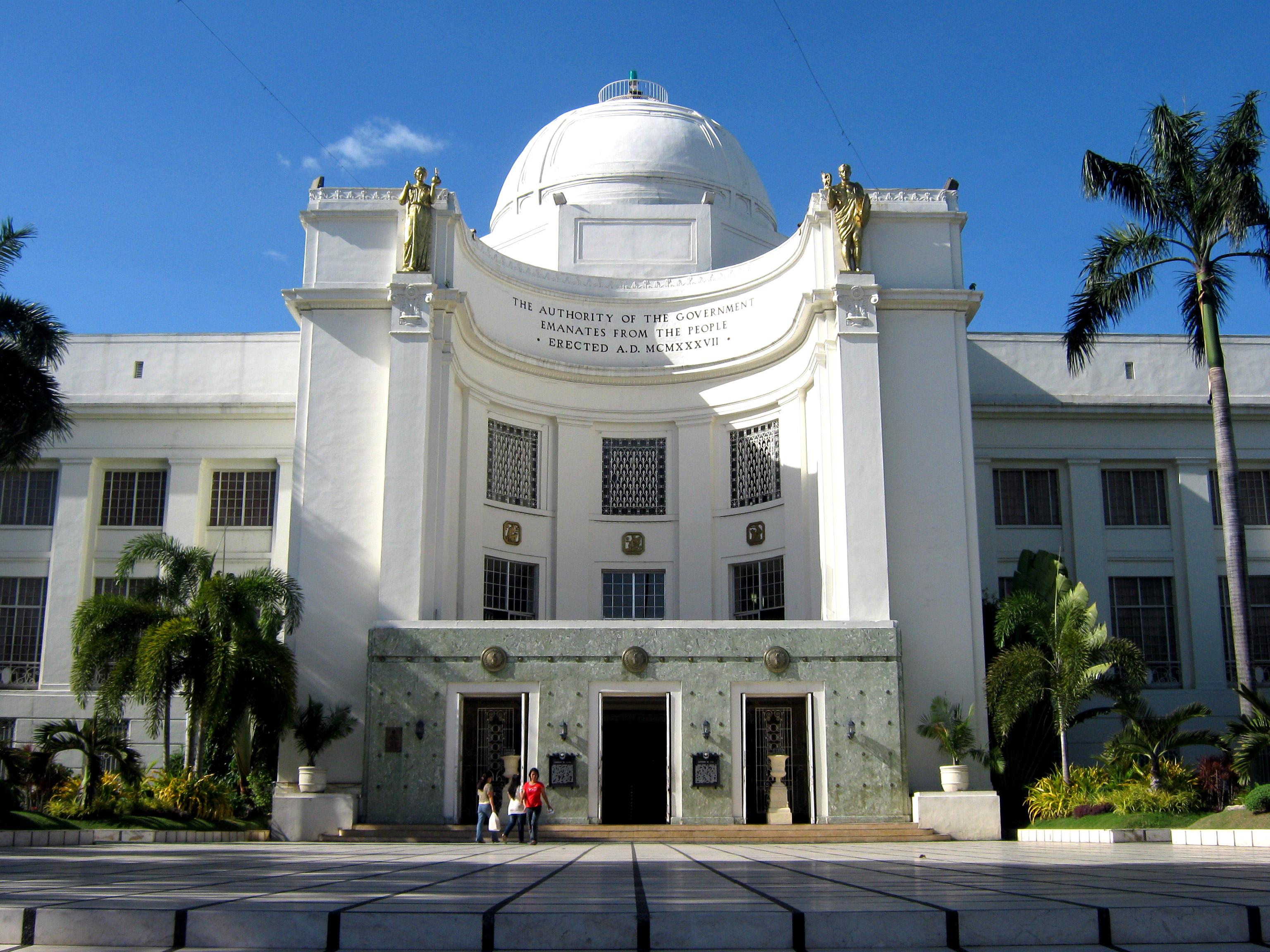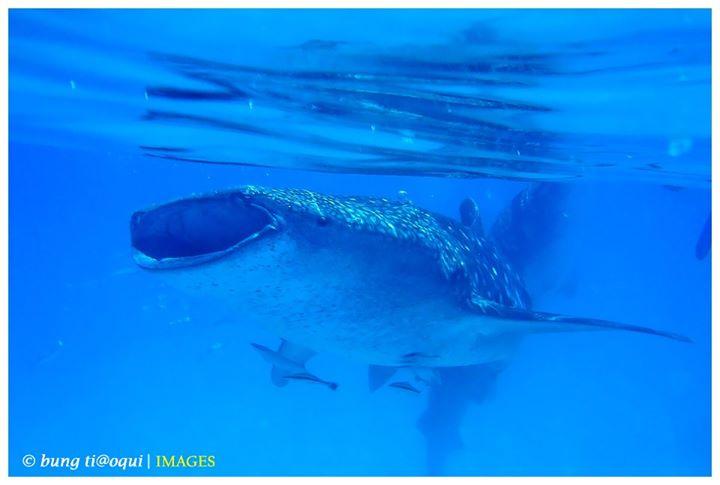
Capitol building of the Province of Cebu, located in Cebu City
Cebu is one of the beautiful destinations in the Philippines, consisting of Cebu Island and 167 surrounding islands. It is located to the east of Negros, to the west of Leyte and Bohol islands. Cebu is a long narrow island stretching 225 kilometers from north to south, surrounded by 167 neighboring, smaller islands, which include Mactan, Bantayan, Malapascua, Olango and the Camotes Islands. Cebu has narrow coastlines, limestone plateaus and coastal plains. It also has rolling hills and rugged mountain ranges traversing the northern and southern lengths of the island. Cebu's highest mountains are over 1000 meters high. Flat tracts of land can be found in the city of Bogo and in the towns of San Remigio, Medellin and Daanbantayan at the northern region of the province. Its capital is Cebu City, the oldest city in the Philippines, which forms part of the Cebu Metropolitan Area together with four neighboring cities which include Danao City, Lapu-Lapu City, Mandaue City and Talisay City and eight other municipalities. Mactan-Cebu International Airport, located in Mactan island, is the second busiest airport in the Philippines.

Cebu is one of the most developed provinces in the Philippines, with Cebu City as the main center of commerce, trade, education and industry in the Visayas. Condé Nast Traveler Magazine named Cebu the 7th best island destination in the Indian Ocean-Asia region in 2007, 8th best Asian-Pacific island destination in 2005, 7th in 2004 and in 2009.
Discovery of Cebu
When Cebu was "discovered" by Ferdinand Magellan in 1521, it was truly a discovery, for it opened the eyes of the world to what it did not expect to see.
We had been a bustling trading post in Asia, long before the first of his ships landed, positioned right in the middle of what was to become the Philippine Archipelago.
The island, with its natural port, was a logical destination, and its people, so steeped in the ways of trade and commerce, were its greatest natural resources.
Fast-forward 436 years, and Cebu remains a discovery. It remains that one bright spot, situated right at the geographic center of the archipelago. It is the fastest growing economy in the country, with an average growth rate significantly higher than that of the entire nation and any other province.
The Province leads 78 other provinces in gross assets, equity and total income.
Cebu is number one?

There is a reason why this small island leads the entire country in exports of furniture, fashion accessories, carageenan, gifts, toys, and houseware.
There is a reason why Cebu consistently gets the biggest chunk of tourist arrivals yearly, and has become the tourist gateway to Central and Southern Philippines. With its urbanized center and stunning natural beauty, Cebu earned its wings as a major player in the tourism in the Philippines.
Cebu as an I.T. and call center capital of the country
Perhaps because the island is naturally situated to become the center of all this action.
It is a natural port. More than 80% of inter-island shipping capacity is based here, on this small island. It is the most accessible place to and from all points in the country, with more domestic air and sea linkages than even Manila.
It is naturally safe. It does not lie within any earthquake zone or typhoon belt. There are no volcanoes on the island.
It has the necessary, well-balanced infrastructure to remain competitive, and to sustain development. And yet, within minutes from its cosmopolitan quarters, you are immediately transported to resort settings and natural wonders.
Why Cebu?
Most of all, because of its people, an independent, self-reliant, entrepreneurial culture pervades the island, which makes its people eminently positioned to seize the opportunities that nature presented it.
We have a highly educated workforce geared towards non-agricultural lines, the reason why Cebu has become the center of global attention for services and information technology.
Cebu is naturally peaceful, with among the lowest crime rates, and the best peace and order records of all cities and provinces in the Philippines.
Tourist Attractions
(Matutinao, Badian, Cebu) - One can feel the coolness of the surrounding lush greenery of this panoramic waterfalls. Accommodations from cheap to moderate rates are available in the area.
It is home to the first Filipino Bishop of Cebu - Juan Gorordo (1862 - 1934). A tour inside this residence is a brief journey into a Filipino lifestyle in particular a period between 1860-1920. This place presently features noted paintings, museum relics, a courtyard, antique household items and furniture.
Open from 10:00 AM to 6:00 PM, Tuesday to Sunday.
(Located in the northwestern tip of Cebu) - Serene and tranquil, and boasting of fine white sand beaches, the island is a favorite holiday hangout, especially during the Lenten Season. The historically rich Holy Week celebration of Bantayan Island is among the most elaborate in the country - using life-size statues during the Holy Thursday and Good Friday processions
(Across the northernmost tip of Cebu) - It was on Christmas day when the Spaniards reached the island. According to townfolks, it was supposed to be a special day for the celebration but unfortunately a storm hit the island and so came the name MALAPASCUA, MALAS SA PASKO, which means "unfortunate Christmas" in English. Malapascua is sometimes referred to as LOGON, the main community in the south. Logon got its name when the Japanese and Americans fought over the island during the World War II . The island is 3kms. long and 1 km. wide with a population of about 3,000. It has white sand beaches and crystal clear waters. The west coast is ideal for swimming and snorkeling but one should be careful because of unpredictable weather. A walk of a tour of the whole island can be done within a day.
(Across Danao City) - The island is located northeast of Cebu province and is composed of 4 towns, namely: Poro, San Francisco, Tudela and Pilar. To cross the island, one can take the boat that leaves from Pier 1 in Cebu City (The Golden Bridge Express) or take the ferry in the Mandaue Warf. Both ferries are bound for Poro. Another would be to go to the Danao City seaport (an hour away from Cebu City) and leave for San Francisco using their large outrigger boats.
Situated 2,000 feet above sea level on the cool hills of Busay, it is and excellent sightseeing spot which offers a breathtaking view of Metro Cebu and the islands of Mactan and Olango. Open kioks are available for daytime picnics and instant evening parties.
The Cathedral Museum of Cebu
(Formerly The Cebu Archdiocesan Museum for the Cultural Heritage of the Church; Located in Manalili cor. P. Gomez Sts., Cebu City; houses Lithurgical Exhibition of Artifacts found in Parishes all over the Province of Cebu, it traces the History of the Parishes and at the same time pinpoints the richness of the cultural legacy of Cebu as the seat of Christianity in the Philippines. The building which housed the temporary collection was the old rectory of the Cebu Metropolitan Cathedral. Old maps of Cebu show that the building has been around since the 19th century - surviving wars, uninformed renovation and the elements. Open from 9:00 AM to 12 noon in the morning and 1:00 PM to 5:00 P.M. in the afternoon, Tuesday to Sunday.
The Museum was first established in the year 1965 by Fr. Ambrosio "boy" J. Galindez, OSA, mainly for the purpose of the commemoration of the Fourth Centennial celebration of the Christianization in the Philippines. It was formerly located at the Basilica del Sto Nino Minore. Vestments and assorted offerings for Sr. Sto. Nino was displayed in a certain room at the convent. The transfer was done after the construction of the Pilgrim center was done in the year 1995 . the main object of the Museum is to make aware of the origin circumstances and events related to the formal Christianization of the Philippines. Open Tuesday to Sunday, 8:00 AM to 4:45 PM (with 11:45 A.M. to 1:30 P.M. as noon-break)
Formally inaugurated by Gov. Gwendolyn F. Garcia on August 5, 2008, the eve of the 349th Founding Anniversary of the Province of Cebu, the Provincial Museum has 12 galleries spread in six buildings, all made of coral stone and lime mortar, the largest collection of Spanish structures ever to be found in a single site in Cebu. Built between 1871 and 1891, these buildings were originally designed by Don Domingo de Escondrillas, the lone engineer-architect of Cebu at the time, as the Carcel del Distrito de Visayas (Visayas District Jail) which later became the Cebu Provincial Jail. Six of the museum's galleries are dedicated to the prehistory and history of Cebu, and are located at the former administration building of the colonial jail. Arranged chronologically, the six covers the prehistory of Cebu with a fine collection of excavated stone tools, boat-shaped coffins and tradeware ceramics, down to the colonial legacy where one find documents from the Legazpi expedition in 1565, objects from the Katipunan uprising in Cebu, and the Sen. Vicente Rama and Justice Sotero Cabahug memorabilia of the American colonial period, among the others. A fine collection of World War II objects as well as the mementoes of the post-war years completes the galleries.
University of San Carlos Museum
The University of San Carlos Museum founded in 1967 by the late German , Fr. Rudolph Rahmann. The Museum is composed of four galleries; (1) Spanish Colonial Gallery, (2) the Ethnographic Gallery, (3) the Archeological Gallery and, (4) the Natural Science Gallery Ethnographic materials from the Buhid Mangyans of Mindoro which was first collected in 1953 by Dr. Marcelino Maceda and consequently was followed by field collection by him and Fr. Rahmann on the material culture of the Negritos of Antique., Panay and Mamanuas of Surigao in 1954. Displayed materials have increased in time as a result of field work of other cultural anthropologists while some have been bought.
Open Monday thru Friday from 8:30 A.M. to 12:00 NN and 1:30 P.M. to 5:00 P.M. ; Saturdays from 8:00 A.M. to 12:00 NN only.
List of Accommodations
• Crimson Resort and Spa - Seascapes Resort Town, Punta Engano, Cebu
• Shangri-La's Mactan Resort & Spa - Punta Engano Road | P.O. Box 86 , Punta Engano, Cebu
• Marco Polo Plaza Cebu Hotel - Cebu Veterans Drive, Nivel Hills, Apas, Cebu City, Cebu, Philippines
• Radisson Blu Hotel Cebu - Serging Osmena Boulevard Corner Juan Luna Avenue, Cebu City, Cebu
• Imperial Palace Waterpark Resort & Spa - M.L Quezon Highway, Maribago, Cebu
• Moevenpick Resort & Spa Cebu - Punta Engano Mactan Island Lapu-Lapu, Punta Engano, Cebu
• Badian Island Resort & Spa - Badian Island, Badian Island, Cebu, Philippines 6301
• Waterfront Airport Hotel and Casino - 1 Airport Road, Lapu-lapu City, Mactan - Airport Area, Cebu
• Cebu Parklane International Hotel - Archbishop Reyes Avenue and Escario St., Cebu City, Cebu
• Waterfront Cebu City Hotel and Casino - 1 Salinas Drive Lahug, Cebu City, Cebu
How to Get There
By Plane: From Manila, there are daily flights going to Cebu City.
By Boat: Cebu City's domestic port is the country's busiest. Cebu City is home to almost 80 percent of the country's passenger vessels. The country's largest shipping lines, namely WG&A, Sulpicio Lines, Trans-Asia, George & Peter Lines and Lorenzo Shipping Lines, are headquartered in Cebu. Large passenger ferries with a capacity of 2,000 to 4,000 passengers ply the more distant routes such as Manila, Davao, Butuan City, Zamboanga, and Cagayan de Oro.
From the airport, you can ride a multicab, jeepney, or taxi. Simply ask around for which route to take. They are available 24 hours and cover most of the nooks and crannies of the city. Just be sure you know what part of the city the jeepney will take you to.










